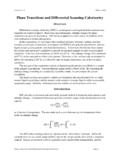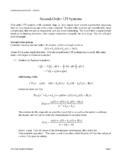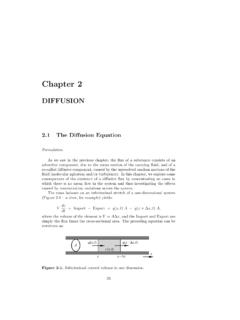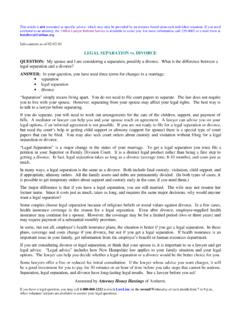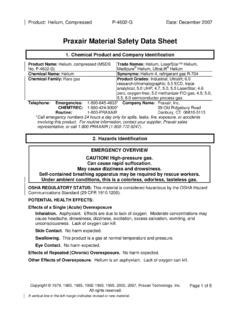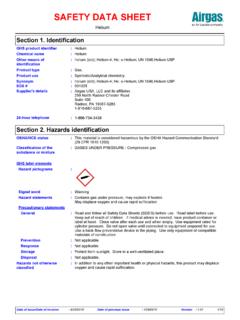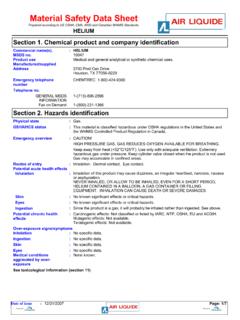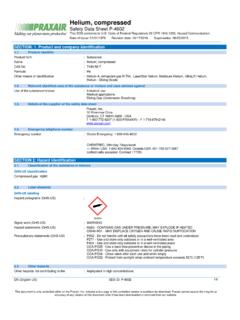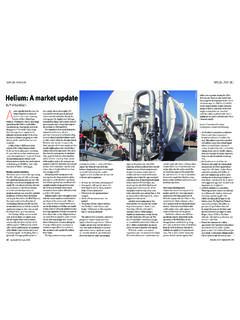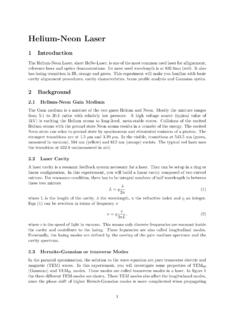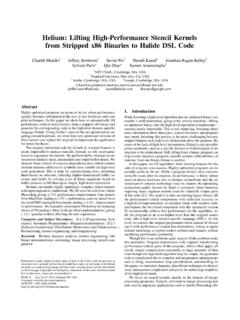Transcription of Helium phase diagram(s) - Dartmouth College
1 Helium phase diagram(s) Helium is a remarkable and unique element. He atoms attract each other so weakly that He remains a gas until K or so at ordinary pressures, and the liquid does not solidify until the pressure is raised to about MPa (or about 25 atm) at temperatures of < K. Liquid Helium is also fascinating in that the weak interactions coupled with the small mass of He leads to the appearance of a liquid-liquid phase transition at around K and 1 atm pressure. The normal liquid undergoes a transition to a super uid phase at and below K; this phase is dominated by macroscopic quantum mechanical phenomena: the liquid ows without viscosity (among other curious behaviors). The diagram below on the left shows the phase diagram for the mass-4 isotope of He (4He). On the right, the heat capacity as one goes through the transition to super uid behavior is shown to have a sharp peak (called a point lambda point because of the shape of the CP(T) curve). Solid He has three distinct forms, two of which are shown in the diagram below.
2 The third appears at pressures higher than shown here. The phase labeled hcp (which stands for hex-agonal close packed ) is one of two ways to pack together spheres as closely as possible. The other way, called fcc for face-centered cubic, is the third solid form mentioned above. The tiny area labeled bcc (for body centered cubic ) represents a phase in which the atoms are not closest packed and thus exhibit a lower density than hcp or fcc. Note that the Solid-Super uid coexistence line is nearly horizontal. What does that tell you?The phase diagram below is for the mass-3 isotope of He (3He), which is the only other stable Helium isotope. It is a completely unique substance by itself, and it is very rare. It has one of the two stable nuclei with more protons (2) than neutrons (1). The other nucleus is, of course, that for ordinary hydrogen, 1H. The unique properties of Helium -3 come from not only its small mass, roughly 75% that of Helium -4, but also to quantum mechanical consequences that are unexpected.
3 The proton and neutron both have nuclear spins with spin quantum numbers of 1/2 (recall how proton NMR works). In 4He, these inherent nuclear angular momenta must add to a total quantum number that is an even integer, and in fact, the sum is zero. But in 3He, the sum must be half integral (it s 1/2, in fact), and that makes a huge di erence. The reasons are beyond our discussion here, but they lead to the appearance of two super uid phases , as shown below. These phases have di erent magnetic behavior. Note as well that compared to 4He, the phase transitions are all found at signi cantly lower temperatures. (The dot in the lower right-hand corner of the diagram locates ordinary conditions.) There is no s-l-g triple point, but there are other triple points. Finally, note the slope of the coexistence boundary between the liquid and solid phases that is circled below. The slope is negative, and it turns out that the reason is due to entropy di erences, not molar volume di erences (as is found in the water phase diagram, for instance).
4 One curious consequence of these entropy di erences is that if you sit on this coexistence line, you have to heat the liquid to freeze it! Helium phase diagram(s) Helium is a remarkable and unique element. He atoms attract each other so weakly that He remains a gas until K or so at ordinary pressures, and the liquid does not solidify until the pressure is raised to about MPa (or about 25 atm) at temperatures of < K. Liquid Helium is also fascinating in that the weak interactions coupled with the small mass of He leads to the appearance of a liquid-liquid phase transition at around K and 1 atm pressure. The normal liquid undergoes a transition to a super uid phase at and below K; this phase is dominated by macroscopic quantum mechanical phenomena: the liquid ows without viscosity (among other curious behaviors). The diagram below on the left shows the phase diagram for the mass-4 isotope of He (4He). On the right, the heat capacity as one goes through the transition to super uid behavior is shown to have a sharp peak (called a point lambda point because of the shape of the CP(T) curve).
5 Solid He has three distinct forms, two of which are shown in the diagram below. The third appears at pressures higher than shown here. The phase labeled hcp (which stands for hex-agonal close packed ) is one of two ways to pack together spheres as close as possible. The other way, called fcc for face-centered cubic, is the third solid form mentioned above. The tiny area labeled bcc (for body centered cubic ) represents a phase in which the atoms are not closest packed and thus exhibit a lower density than hcp or fcc. Note that the Solid-Super uid coexistence line is nearly horizontal. What does that tell you?The phase diagram below is for the mass-3 isotope of He (3He), which is the only other stable Helium isotope. It is a completely unique substance by itself, and it is very rare. It has one of the two stable nuclei with more protons (2) than neutrons (1). The other nucleus is, of course, that for ordinary hydrogen, 1H. The unique properties of Helium -3 come from not only its small mass, roughly 75% that of Helium -4, but also to quantum mechanical consequences that are unexpected.
6 The proton and neutron both have nuclear spins with spin quantum numbers of 1/2 (recall how proton NMR works). In 4He, these inherent nuclear angular momenta must add to a total quantum number that is an even integer, and in fact, the sum is zero. But in 3He, the sum must be half integral (it s 1/2, in fact), and that makes a huge di erence. The reasons are beyond our discussion here, but they lead to the appearance of two super uid phases , as shown below. These phases have di erent magnetic behavior. Note as well that compared to 4He, the phase transitions are all found at signi cantly lower temperatures. (The dot in the lower right-hand corner of the diagram locates ordinary conditions.) There is no s-l-g triple point, but there are other triple points. Finally, note the slope of the coexistence boundary between the liquid and solid phases that is circled below. The slope is negative, and it turns out that the reason is due to entropy di erences, not molar volume di erences (as is found in the water phase diagram, for instance).
7 One curious consequence of these entropy di erences is that if you sit on this coexistence line, you have to heat the liquid to freeze it!


